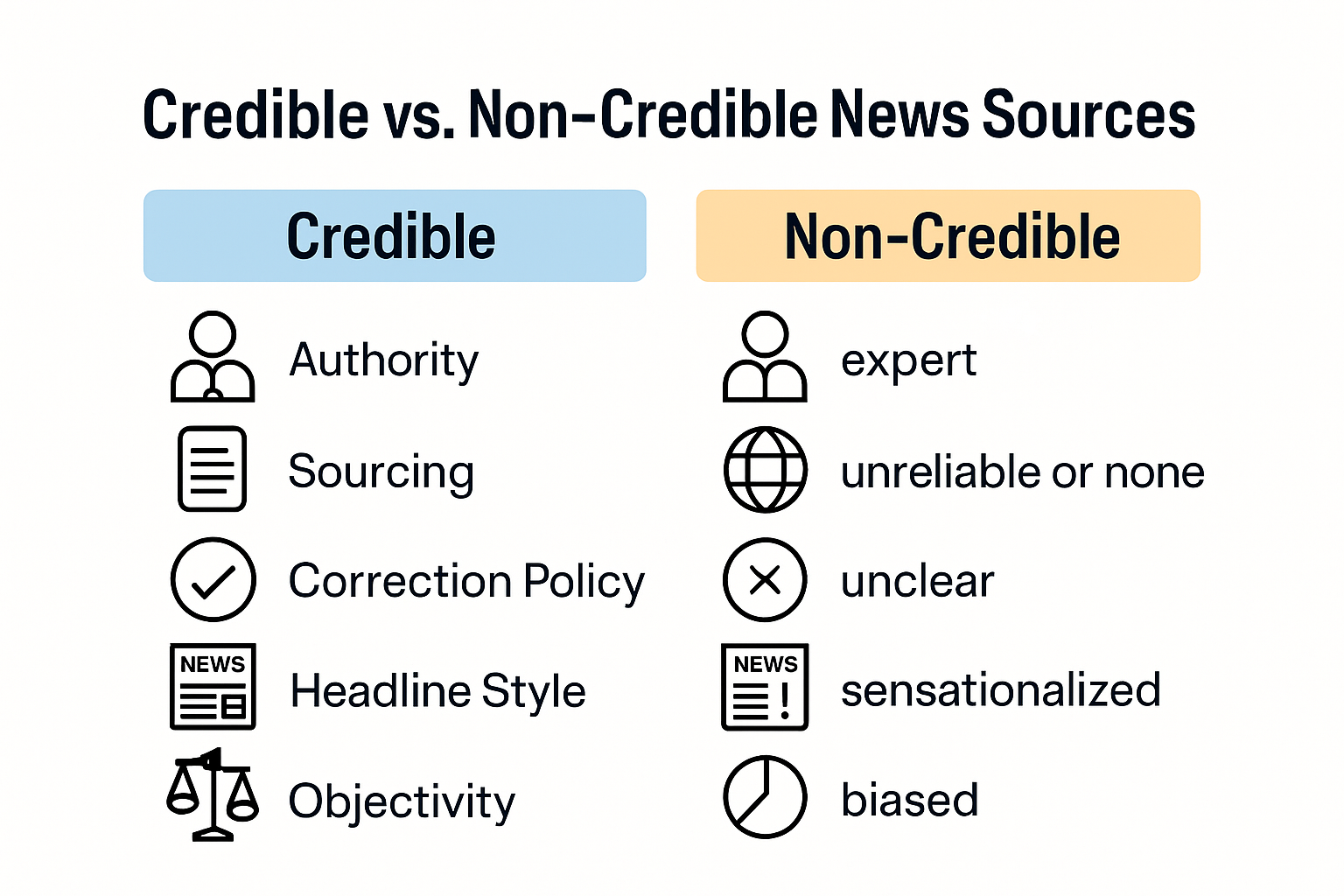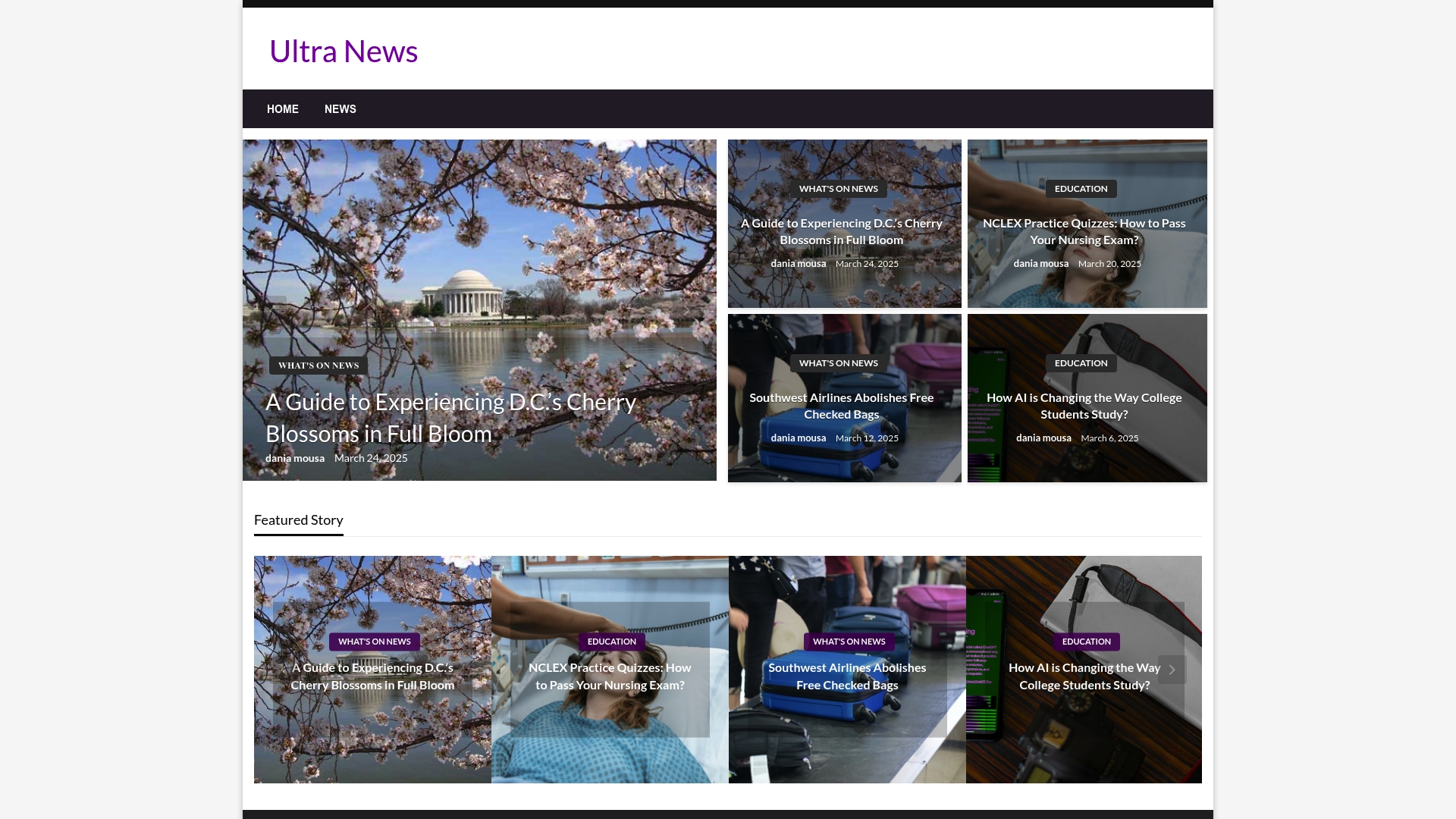
Sorting facts from fiction online is harder than ever, and nearly 60 percent of Americans say they regularly see fake news in their feeds. You might think every website with a clean design or a popular logo is trustworthy. But even the most professional-looking news site can be misleading if you do not know what signals to trust. Let’s unpack the simple checks that can reveal who is actually telling the truth.
Table of Contents
- What Makes A News Source Credible
- Top Examples Of Credible News Sources
- How To Spot False Or Biased News
- Tips For Finding Reliable News Every Day
Quick Summary
| Takeaway | Explanation |
|---|---|
| Evaluate sources for expertise | Check if the news outlet employs professional journalists with verifiable credentials and strong reporting backgrounds. |
| Look for evidence-based reporting | Confirm that articles cite clear sources, offer corrections, and separate news from opinion for transparency and accuracy. |
| Diversify your news sources | Avoid bias by consuming news from various reputable outlets across platforms and perspectives to obtain well-rounded information. |
| Spot red flags in news content | Identify sensationalism, lack of credible sourcing, and unusual domain names to spot potentially misleading news. |
| Develop critical reading skills | Engage actively with news by examining context, understanding primary sources, and differentiating news from opinions for deeper insights. |
What Makes a News Source Credible
Identifying credible news sources requires a systematic approach to evaluating information quality and reliability. Not all news outlets are created equal, and understanding the key characteristics that distinguish trustworthy sources from questionable ones is crucial in today’s complex media landscape.
Authority and Expertise
The foundation of a credible news source lies in its authority and expertise. Reputable news organizations employ professional journalists with strong backgrounds in reporting and fact-checking. Learn more about media expertise highlights the importance of understanding an organization’s journalistic standards.
According to the University of Rio Grande, credible sources are typically authored by experts and come from established organizations. This means looking for news outlets with professional journalists who have verifiable credentials, track records of accurate reporting, and clear editorial standards. Publications affiliated with respected academic or professional institutions often demonstrate higher levels of credibility.
Evidence-Based Reporting and Transparency
Credible news sources prioritize evidence-based reporting and maintain high standards of transparency. The CRAAP test developed by California State University provides a comprehensive framework for evaluating information sources based on Currency, Relevance, Authority, Accuracy, and Purpose.
Key indicators of credible reporting include:
- Clear sourcing: Articles that cite multiple sources and provide direct references to original research or official statements
- Distinguishing between news and opinion: Reputable outlets clearly separate factual reporting from editorial commentary
- Correction policies: Transparent news organizations quickly acknowledge and correct errors when they occur
Objective and Balanced Perspective
Trustworthy news sources strive to present balanced and objective reporting. According to the University of Texas at El Paso, evaluating credibility involves examining multiple factors, including the publication’s domain, author credentials, and publication date.
Objective reporting means:
- Presenting multiple perspectives on complex issues
- Avoiding sensationalism or inflammatory language
- Providing context and nuanced understanding of events
- Minimizing personal bias in news coverage
By applying these critical evaluation criteria, readers can more effectively distinguish between credible news sources and unreliable or biased information platforms. Developing media literacy skills empowers individuals to make informed decisions about the news they consume and share.

Top Examples of Credible News Sources
Identifying reliable news sources is crucial in an era of information overload. While numerous outlets exist, some consistently demonstrate higher standards of journalistic integrity and accuracy. Explore the nuances of news media provides deeper insights into evaluating media sources.
Traditional Print Media with Strong Digital Presence
Traditional print publications have successfully transitioned to digital platforms while maintaining their reputation for quality reporting. According to the Purdue University Online Writing Lab, these sources often have rigorous fact-checking processes and established editorial standards.
Top credible news sources in this category include:
- The New York Times: Known for in-depth reporting and comprehensive global coverage
- The Washington Post: Recognized for investigative journalism and political reporting
- The Wall Street Journal: Respected for business and economic news with meticulous reporting
Public Broadcasting and Academic Resources
Public broadcasting and academic-affiliated news sources offer balanced and well-researched information. The Journalist’s Resource from Harvard Kennedy School exemplifies how academic institutions contribute to high-quality news reporting.
Notable credible sources in this category include:
- NPR (National Public Radio): Provides nuanced reporting with multiple perspectives
- BBC News: Offers international coverage with a commitment to objectivity
- Reuters: Known for neutral, fact-based international news reporting
Specialized and Investigative News Platforms
Some news platforms specialize in specific areas or focus on in-depth investigative reporting. These sources often provide comprehensive analysis and rigorous fact-checking.
Examples of specialized credible news sources:
- ProPublica: Nonprofit newsroom focusing on investigative journalism
- Associated Press (AP): Widely recognized for factual, non-partisan reporting
- The Economist: Offers detailed global analysis with a focus on economic and political trends
When selecting news sources, readers should remain critical and cross-reference information. No single source is infallible, and consuming news from multiple credible outlets helps develop a more comprehensive understanding of complex issues.
Below is a table summarizing categories of credible news sources and their characteristics, making it easier to compare their focus and strengths as discussed in the article.
| News Source Category | Example Outlets | Area of Focus | Key Strength |
|---|---|---|---|
| Traditional Print, Digital Presence | The New York Times, The Washington Post, The Wall Street Journal | Investigative journalism, in-depth national and global reporting | Rigorous fact-checking, established editorial standards |
| Public Broadcasting & Academic | NPR, BBC News, Reuters | International, balanced news | Objective reporting, multiple perspectives |
| Specialized & Investigative Platforms | ProPublica, Associated Press, The Economist | Investigative, specialized analysis | Comprehensive analysis, non-partisan coverage |
How to Spot False or Biased News
In the digital age, distinguishing between factual reporting and misleading information has become increasingly challenging. False and biased news can spread rapidly, potentially influencing public opinion and personal understanding of critical issues. Explore media literacy strategies to enhance your ability to critically evaluate news content.
Identifying Red Flags in News Content
Detecting false or biased news requires a systematic approach to analyzing information. The Digital Literacy Resource Platform suggests several key indicators that can help readers identify potentially unreliable sources.
Critical red flags include:
The following table provides a handy checklist for spotting red flags in news articles, helping readers quickly assess whether an article may be false or biased as described in the section.
| Red Flag Feature | Description | Present in Article? |
|---|---|---|
| Sensationalist headlines | Overly dramatic or emotionally charged titles | [ ] |
| Lack of verifiable sources | Article does not cite specific references or experts | [ ] |
| Unusual website domains | Suspicious or unofficial website URLs | [ ] |
| Anonymous sourcing | Heavy reliance on unnamed or anonymous sources | [ ] |
| Inflammatory tone | Use of language intended to provoke strong emotions or reactions | [ ] |
- Sensationalist headlines: Overly dramatic or emotionally charged titles designed to provoke strong reactions
- Lack of verifiable sources: Articles that do not cite specific references or experts
- Unusual website domains: Suspicious URLs that mimic legitimate news sites but are not official publications
Analyzing Source Credibility and Context
Careful examination of a news source’s background and presentation can reveal potential bias or misinformation. According to Media Literacy Project research, readers should consider multiple factors when evaluating news content:
- Check the author’s credentials and professional background
- Verify if the publication date is current and relevant
- Compare the story with reports from multiple reputable sources
- Look for balanced reporting that presents multiple perspectives
Fact-Checking and Verification Techniques
Developing robust fact-checking skills is essential in combating misinformation. Readers can utilize various strategies to verify news content:
- Use dedicated fact-checking websites like Snopes or FactCheck.org
- Cross-reference information with multiple credible sources
- Be skeptical of articles that rely heavily on anonymous sources
- Look for direct quotes and verifiable evidence
- Pay attention to the tone and language used in the article
Navigating the complex world of online news requires critical thinking and a commitment to seeking accurate information. By developing media literacy skills and maintaining a skeptical yet open-minded approach, individuals can better protect themselves from false and biased news sources. Remember that responsible news consumption involves continuous learning and a willingness to challenge one’s own assumptions.
Ultimately, the most effective defense against misinformation is an educated and discerning reader who values truth and seeks to understand the nuanced complexities of current events.
Tips for Finding Reliable News Every Day
Staying informed with accurate and trustworthy news requires consistent effort and strategic approaches. Discover practical media navigation strategies to enhance your daily news consumption.
Diversify Your News Sources
Relying on a single news outlet can lead to limited perspectives and potential bias. The American Press Institute recommends creating a diverse news diet that includes multiple reputable sources across different platforms and ideological perspectives.
Effective strategies for source diversification include:
- Rotate news sources: Read coverage of the same event from different respected publications
- Mix media types: Combine print, digital, broadcast, and specialized news sources
- International perspectives: Include international news outlets to gain broader understanding
- Depth and breadth: Balance breaking news with long-form investigative reporting
Develop Active Reading and Critical Thinking Skills
Consuming news is not passive. According to Stanford History Education Group, developing active reading skills is crucial for understanding complex information. This involves more than just scanning headlines.
Key critical reading techniques:
- Read beyond headlines
- Examine the full context of stories
- Look for primary sources and direct quotes
- Understand the difference between news reporting and opinion pieces
- Track the credibility of information sources

Leverage Technology and Tools
Modern technology offers powerful tools for verifying and understanding news. Digital platforms and applications can help readers navigate the complex media landscape more effectively.
Recommended technological approaches:
- Use fact-checking websites like Snopes and FactCheck.org
- Install browser extensions that provide source credibility ratings
- Follow reputable media literacy organizations on social platforms
- Use news aggregator apps that curate content from multiple sources
- Set up Google Alerts for topics of interest to track consistent reporting
Building a robust news consumption strategy takes time and continuous learning. The digital media landscape evolves rapidly, and staying informed requires adaptability, curiosity, and a commitment to understanding complex issues from multiple perspectives.
Remember that being an informed citizen is an active process. By implementing these strategies, you can develop a more nuanced, comprehensive understanding of current events while protecting yourself from misinformation and biased reporting.
Frequently Asked Questions
What are some characteristics of credible news sources?
Credible news sources typically have professional journalists with expertise, prioritize evidence-based reporting, maintain transparency, and present balanced and objective perspectives in their journalism.
How can I identify biased or false news?
To identify biased or false news, look for sensationalist headlines, lack of verifiable sources, unusual website domains, and inflammatory language. Additionally, consider the author’s credentials and cross-reference the information with other reputable sources.
Why is it important to diversify my news sources?
Diversifying your news sources helps you gain a well-rounded perspective on current events, reduces the likelihood of being exposed to bias, and allows you to understand different viewpoints on complex issues.
What tools can I use to evaluate the credibility of news articles?
You can use fact-checking websites like Snopes or FactCheck.org, browser extensions for source credibility ratings, and news aggregator apps that curate information from multiple reliable sources to evaluate the credibility of news articles.
Take Control of Your News: Make Smarter Choices on Ultra News
Tired of feeling overwhelmed by unreliable headlines and constant misinformation? You are not alone. As explored in our guide to finding credible news sources online, today’s readers face real challenges in separating facts from bias. If you have struggled with sensationalist stories or uncertain sources, Ultra News is here to help you find clarity. Our site puts evidence-based journalism and educational resources right at your fingertips, so you never have to wonder about the reliability of what you read.

Ready to break the cycle of uncertainty and trust what you read? Visit Ultra News for a carefully curated stream of international updates, expert analysis, and actionable guides just like this one. Explore our Education section to strengthen your critical reading skills, or browse all our latest news articles for timely and trustworthy coverage. Stay informed with confidence—start your better news experience today.




